Interstitial fluid Study guides, Class notes & Summaries
Looking for the best study guides, study notes and summaries about Interstitial fluid? On this page you'll find 9764 study documents about Interstitial fluid.
Page 3 out of 9.764 results
Sort by
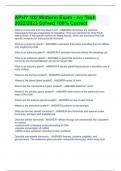
-
APHY 102 Midterm Exam - Ivy Tech 2022/2023 Solved 100% Correct
- Exam (elaborations) • 14 pages • 2023
- Available in package deal
-
- $12.49
- 3x sold
- + learn more
What is a hormone and how does it act? - ANSWER-Hormones are chemical messengers that are responsible for regulation. They are secreted into body fluids, mainly blood. It has specific actions on target tissues, which are any tissue that has specific receptors for that particular hormone. What is a paracrine gland? - ANSWER-a secretion that enters interstitial fluid but affects only neighboring cells What is an autocrine gland? - ANSWER-A secretion that only affects the secreting cell. W...
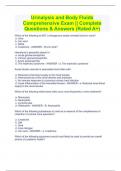
-
Urinalysis and Body Fluids Comprehensive Exam || Complete Questions & Answers (Rated A+)
- Exam (elaborations) • 21 pages • 2024
- Available in package deal
-
- $13.99
- 1x sold
- + learn more
Urinalysis and Body Fluids Comprehensive Exam || Complete Questions & Answers (Rated A+) Urinalysis and Body Fluids Comprehensive Exam || Complete Questions & Answers (Rated A+) Which of the following is NOT a nitrogenous waste normally found in urine? a. Urea b. Uric acid c. Nitrite d. Creatinine - ANSWER - B Uric Acid? Hematuria is generally absent in: a. Acute glomerulonephritis b. Chronic glomerulonephritis c. Acute pyelonephritis d. The nephrotic syndrome - ANSWER - d...
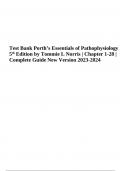
-
Test Bank Porth’s Essentials of Pathophysiology 5th Edition by Tommie L Norris Chapter 1-28 | Complete Guide Latest Version 2023/2024
- Exam (elaborations) • 421 pages • 2023
- Available in package deal
-
- $35.49
- 2x sold
- + learn more
Test Bank Porth’s Essentials of Pathophysiology 5th Edition by Tommie L Norris Chapter 1-28 | Complete Guide Latest Version 2023/2024. The manifestations of a disease are best defined as the: a. subjective feelings of discomfort during a chronic illness. b. signs and symptoms of a disease. c. factors that precipitate an acute episode of a chronic illness. d. early indicators of the prodromal stage of infection. ANS: B REF: 6 3. The best definition of the term prognosis is the: a. precip...
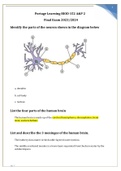
-
Portage Learning BIOD 152 A&P 2 Final Exam 2023/2024
- Exam (elaborations) • 31 pages • 2023
- Available in package deal
-
- $15.49
- 10x sold
- + learn more
Portage Learning BIOD 152 A&P 2 Final Exam 2023/2024 Identify the parts of the neuron shown in the diagram below a. dendrite b. cell body c. nucleus List the four parts of the human brain The human brain is made up of the cerebral hemispheres, diencephalon, brain stem, andcerebellum. List and describe the 3 meninges of the human brain. The leathery dura mater is the double-layered outer meninx. The middle arachnoid meninx is a loose layer separated from the dura...
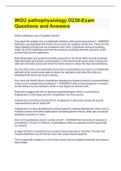
-
WGU pathophysiology D236-Exam Questions and Answers
- Exam (elaborations) • 32 pages • 2022
-
- $9.49
- 17x sold
- + learn more
What is Starling's Law of Capillary forces? How does this explain why a nutritionally deficient child would have edema? - ANSWER Starling's Law describes how fluids move across the capillary membrane. There are two major opposing forces that act to balance each other, hydrostatic pressure (pushing water out of the capillaries) and osmotic pressure (including oncontic pressure, which pushes fluid into the capillaries). Both electrolytes and proteins (oncontic pressure) in the blood affe...
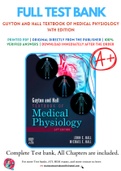
-
Test Bank for Guyton and Hall Textbook of Medical Physiology 14th Edition By John E. Hall; Michael E. Hall Chapter 1- 85 Complete Guide A+
- Exam (elaborations) • 266 pages • 2023
-
- $29.08
- 3x sold
- + learn more
Test Bank for Guyton and Hall Textbook of Medical Physiology 14th Edition By John E. Hall; Michael E. Hall Chapter 1- 85 Complete Guide A+ 7128, 2 1. Functional Organization of the Human Body and Control of the “Internal Environment” 2. The Cell and Its Functions 3. Genetic Control of Protein Synthesis, Cell Function, and Cell Reproduction 4. Transport of Substances Through Cell Membranes 5. Membrane Potentials and Action Potentials 6. Contraction of Skeletal Muscle 7...
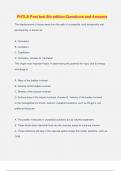
-
PHTLS Post test 9th edition Questions and Answers
- Exam (elaborations) • 25 pages • 2024
-
- $13.49
- 1x sold
- + learn more
PHTLS Post test 9th edition Questions and Answers The displacement of tissue away from the path of a projectile, both temporarily and permanently, is known as: A. Conization B. Cavitation C. Crepitation D. Contusion -Answer-B. Cavitation The single most important factor in determining the potential for injury due to energy exchange is: A. Mass of the bodies involved B. Velocity of the bodies involved C. Density of the tissues involved D. Surface area of the impact involved -Answer-B....
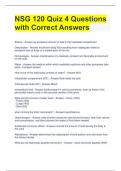
-
NSG 120 Quiz 4 Questions with Correct Answers
- Exam (elaborations) • 13 pages • 2023
- Available in package deal
-
- $12.49
- 1x sold
- + learn more
NSG 120 Quiz 4 Questions with Correct Answers Edema - Answer-an excessive amount of fluid in the interstitial compartment Dehydration - Answer-insufficient body fluid resulting from inadequate intake or excessive loss of fluids or a combination of the two Homeostasis - Answer-maintenance of a relatively constant and favorable environment for the cells Water - Answer-the medium within which metabolic reactions and other processes take place. Transport system How much of the adult bo...

-
Biol 230 Athabasca Unit 1 Exam Questions And Answers (Verified And Updated)
- Exam (elaborations) • 14 pages • 2024
-
- $12.49
- 1x sold
- + learn more
Biol 230 Athabasca Unit 1 Exam Questions And Answers (Verified And Updated) Integration: - answerThe process in which the bodies systems work together to accomplish a unified/common task emergent properties - answerIn a complex hierarchy such as the body's organizational plan, as each level gives rise to the next highest level, new properties emerge that are not present at the levels below Metabolism: - answerThe sum of all the chemical reactions that occur in the body (catabolism "br...

-
ALMS - Anatomy and Physiology: All Modules Questions With 100% Correct
- Exam (elaborations) • 59 pages • 2024
- Available in package deal
-
- $7.99
- 1x sold
- + learn more
Which layer of serous membrane lines the walls of cavities? - Answer-Visceral (wrong) Which directional term, also known as dorsal, means nearer to or at the back of the body? - AnswerPosterior Which type of tissue produces chemicals and fluid that digests food in the stomach? - Answer-Muscle (wrong) Which term describes the study of the function of components of the body? - Answer-Physiology Eight chemical elements constitute 3.6 percent of total body mass. What are these chemical elements...

$6.50 for your textbook summary multiplied by 100 fellow students... Do the math: that's a lot of money! Don't be a thief of your own wallet and start uploading yours now. Discover all about earning on Stuvia


